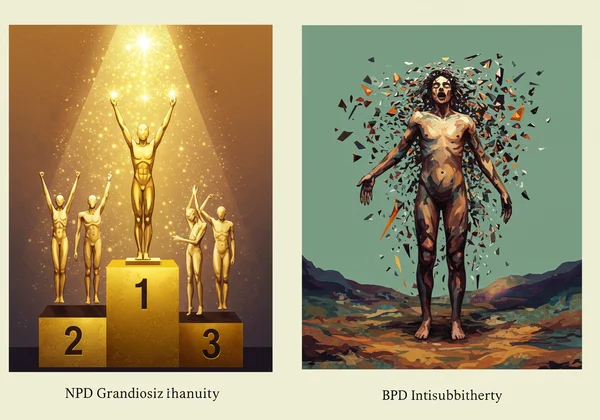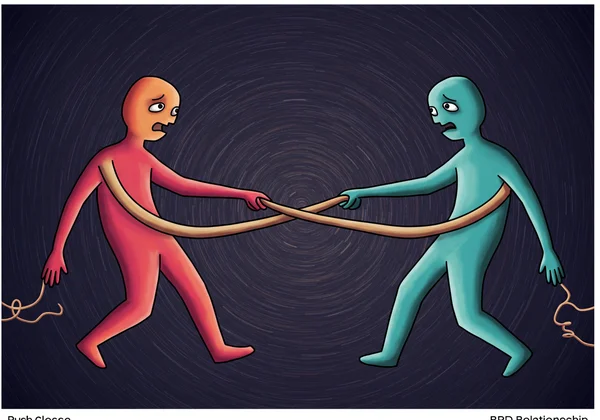NPD 与 BPD:解读关键差异并借助自恋症测试进行理解
您是否正在努力理解亲人复杂的个性模式,发现自己难以抉择,不确定是自恋型人格障碍 (NPD) 还是边缘型人格障碍 (BPD)?这两种情况虽然不同,但行为上存在重叠,常导致混淆。如果您正在寻找对 NPD 与 BPD 的清晰认识,那么您并不孤单。您如何识别自恋者或边缘型人格模式? 本指南旨在揭示 NPD 和 BPD 的神秘之处,阐明其在症状、动机和关系动态方面的核心差异,从而帮助您更好地理解这些复杂情况。虽然此信息仅用于教育目的,但获得洞察力是第一步,我们的 自恋症评估 以及选择进行免费自恋症测试可以作为自我反思的有用起点。
NPD 与 BPD 症状:比较分析
乍一看,NPD 和 BPD 的强烈情绪表现和棘手的人际行为可能惊人地相似。两者都可能涉及操纵、愤怒以及在关系中制造冲突的倾向。然而,仔细审视核心症状会发现它们在心理结构上存在根本性差异。理解这些差异对于任何试图驾驭这些复杂动态的人来说都至关重要。
自大与不稳定:NPD 的核心特征

自恋型人格障碍的标志是一种普遍存在的 自大 模式。这不仅仅是高自尊;这是一种稳定但脆弱的信念,认为自己优越、独特且理应享有特权。NPD 患者将其整个身份建立在这种膨胀的自我形象之上。他们内心深处渴望他人的钦佩,以不断验证这种特殊感。
这种核心的自大表现在傲慢、沉迷于无限成功或权力的幻想,以及坚信自己应得到特殊待遇等行为中。虽然他们可能会经历情绪爆发(通常被称为“自恋性暴怒”),但这通常是在他们的优越感受到挑战或被忽视时触发的。他们的自我意识,尽管膨胀,但却异常一致——他们永远是自己故事中的英雄。
BPD 中的 强烈情绪失调
相比之下,边缘型人格障碍的决定性特征是深刻的不稳定。这种不稳定渗透到一个人生活的方方面面:他们的情绪、人际关系、行为,甚至他们的自我意识。NPD 患者拥有一个固定的(尽管是夸大的)身份,而 BPD 患者则经常经历一种慢性的空虚感和破碎或不断变化的 身份认同障碍。
最易识别的症状是 情绪失调。他们的情绪会迅速而强烈地波动,在数小时内从狂喜转变为绝望或愤怒。这种情绪波动通常是对人际压力源的反应,尤其是对被遗弃的恐惧。他们的行为,即使是最具自我毁灭性的行为,也常常是管理这些压倒性情绪的绝望尝试。
重叠之处:共同特征与诊断挑战
NPD 和 BPD 之间的混淆往往源于它们共同的行为特征。两者都可能对批评高度敏感,倾向于非黑即白思维(分裂),并倾向于操纵他人以满足自身需求。当他们感到被轻视或威胁时,两者都可能贬低他人。
然而,这些行为背后的 原因 有所不同。NPD 患者贬低那些不再提供钦佩或挑战其自大的人。BPD 患者贬低那些他们害怕会抛弃他们的人,这通常是一种先发制人的打击,以避免被拒绝的痛苦。理解这些潜在动机是区分两者的关键。如果这些模式与您产生共鸣,那么通过结构化评估进一步 探索自恋特质 可能会很有用。
剖析动机:NPD 和 BPD 患者行为差异的原因
要真正理解 NPD 和 BPD 之间的差异,我们必须超越他们所 做 的,而去探究他们 为什么 这样做。这两种人格结构的核心心理驱动力是根本对立的,导致即使表面行为相似,也存在不同的行为模式。
BPD 中 根深蒂固的被遗弃恐惧

BPD 患者的整个心理世界都围绕着一种可怕的、吞噬一切的被遗弃恐惧。这种恐惧不仅仅是随意的担忧;这是一种存在的恐惧,担心自己会被独自留下而无法应对。这种核心创伤驱动着他们最具特征的行为。
为了避免真实或想象中的遗弃,他们会做出疯狂的努力,包括黏人、不断寻求安慰,甚至自残,以此作为绝望的连接呼唤。他们强烈而不稳定的关系是这种恐惧的直接结果。他们正在寻找一种无条件的爱,最终能让他们感到安全,但他们自身的情绪波动却常常推开那些他们试图抓住的人。
对钦佩的需求:理解 NPD 的核心驱动力

对于 NPD 患者来说,主要动机不是避免被遗弃,而是不懈地追求 自恋性供给。这指的是任何形式的关注或钦佩,能够滋养他们夸大的自我概念。他们的自我价值完全外化;它取决于他人反映出他们所感知的伟大。
他们寻找能够提升其地位并使其看起来不错的人、工作和财产。他们的人际关系通常是交易性的——他们根据他人能提供何种钦佩、地位或资源来评价他人。当这种供给耗尽,或者当一个人不再是奉承的镜子时,他们就会迅速被贬低和抛弃。这种核心驱动力解释了他们深刻的缺乏同理心,因为他人不被视为有自己感受的个体,而是被视为验证自我的工具。认识到这种模式可能会促使您通过客观工具 获得一些清晰的认识。
关系模式:NPD 和 BPD 如何影响他人
NPD 和 BPD 不同的动机在人际关系中产生了截然不同但同样具有挑战性的动态。对于伴侣、朋友或家人来说,识别这些模式可能是理解并设定健康界限的第一步。
BPD 关系中的 推拉动态

与 BPD 患者的关系通常以强烈而混乱的 推拉动态 为特征。这种循环是由他们对被遗弃和被吞噬的矛盾恐惧所驱动的。前一刻,他们会理想化伴侣,将对方视为完美的救世主。他们会以强烈的情感和热情将伴侣拉近。
然而,哪怕是轻微的被轻视或退缩的迹象,都可能触发他们对被遗弃的恐惧,导致他们突然贬低伴侣。他们可能会变得极其愤怒、指责和挑剔,将伴侣推开。这种令人眩晕的理想化和贬低循环让亲人感到困惑、疲惫,并时刻如履薄冰。
自恋性剥削 和缺乏同理心
与 NPD 患者的关系较少涉及情感混乱,更多的是剥削和控制。这种关系的存在是为了满足 NPD 患者的需求。他们常常在早期阶段通过魅力和理想化新伴侣(“爱意轰炸”)来确保对方成为自恋性供给的来源。
一旦关系建立,他们深刻的 缺乏同理心 就会显现出来。他们常常无法或不愿识别或认同他人的感受和需求。伴侣被视为他们自身的延伸,被期望毫无疑问地满足他们的需求。伴侣任何试图表达自身需求或感受的尝试,往往会遭到漠视、煤气灯操纵或暴怒。如果这种动态让您感到熟悉,一个 自我反思工具 可能会提供有价值的见解。
寻求清晰与支持:您的下一步
区分自恋型人格障碍和边缘型人格障碍具有挑战性,因为两者都呈现出复杂而痛苦的人际动态。关键区别在于障碍的核心:NPD 围绕着一个稳定、夸大的自我形象,需要外部的钦佩,而 BPD 则由不稳定的自我意识和根深蒂固的被遗弃恐惧所定义。
这些知识并非旨在诊断任何人,这项任务应始终留给合格的心理健康专业人士。相反,它的目的是赋予您清晰的认识。理解潜在的动机可以帮助您理解令人困惑的行为并保护自己的福祉。如果您的观察更符合自大、特权感和缺乏同理心的模式,您可能希望了解更多关于自恋症的信息。进行 免费自恋症测试 可以是您探索和理解之旅中富有洞察力的第一步。
关于 NPD 和 BPD 的常见问题
是否可能同时患有 NPD 和 BPD?
是的,共病是可能的。一个人可以同时被诊断患有 BPD 和 NPD,或者同时具有两者的特质。在这些情况下,专业的诊断对于理清复杂的症状表现并制定有效的治疗计划至关重要。
NPD 和 BPD 患者的关系模式有何不同?
主要区别在于动机。BPD 关系是一种由被遗弃恐惧驱动的混乱“推拉”模式。NPD 关系通常是剥削性的,伴侣的存在是为了提供“自恋性供给”并验证个体的自大。
为什么 NPD 和 BPD 常常被混淆?
它们之所以常常被混淆,是因为两者都可能涉及强烈的情绪反应、操纵行为,以及非黑即白地看待他人(理想化和贬低)的倾向。然而,这些行为的根本原因——BPD 中对被遗弃的恐惧与 NPD 中对钦佩的需求——截然不同。对于那些特别想了解自恋症的人,进行 自恋症测试 可以初步了解这些特质。
如果我怀疑某人患有 NPD 或 BPD,我该怎么办?
最重要的一步是优先考虑您自己的心理健康和安全。了解这些状况,设定明确的界限,并寻求治疗师或支持小组的帮助。诊断或“修复”他人不是您的责任。您的重点应该是为自己创造一个健康稳定的环境。